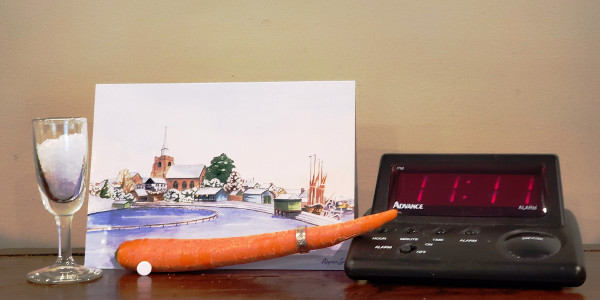Significance or Coincidence?
A few days ago, I accidently dropped my vitamin D pill on the kitchen counter. It bounced a few times, rolled, and came to rest on its edge rather than on its side! Incredible, I thought. What were the chances of that?
My wife, Annie, says that when she looks at a digital clock, she’s surprised how often the time is 11:11. Very perplexing—why should this special time come up more frequently than other times?
We recently bought a box of Maldon Sea Salt. According to the manufacturer, this special salt is composed of “soft crunchy flakes”. It’s been made in Maldon, a tiny town on the Blackwater estuary in Essex, England, for four generations. Shortly after buying the salt, I got a birthday card from a good friend who lives in Portland. The card featured a lovely painting of the very same Maldon! Entitled “The Promenade,” it included a church, and a glimpse of the waterfront where the boats that collect the salty estuary water that’s turned into those soft, crunchy flakes are moored. When Diane called to wish me happy birthday, she told me she bought the card many years ago during a trip to the UK. For some reason, she felt impressed to choose it for my birthday this year. Amazing that she had held on to it for all those years, and finally sent it just after we bought some Maldon salt! How likely was that?
In 1995 Lena Paahlsson lost her wedding band, which was studded with seven small diamonds. She had taken off the ring to do some Christmas baking in her kitchen in Mora, a little town in central Sweden. (By the way, coincidently—or maybe not—Mora and Maldon not only both begin with an “M,” but have almost exactly the same population.) Alas, the ring disappeared from the work surface. Lena and her husband, Ola, searched everywhere. They even pulled up the kitchen floor tiles during a subsequent remodel to look for it, but no luck. Then, sixteen years later, while harvesting vegetables in her garden the ring turned up, encircling a freshly picked carrot! Lena and Ola speculated that the ring had been swept up from the counter along with fruit and vegetable peelings, found its way first to the compost pile, and then into the garden. Perhaps just as miraculous as the ring’s recovery was that the article reporting this story failed to attempt any puns referring to the weight of the diamonds on Lena’s ring as gaining a carrot.
These four disparate stories are linked by the fact that each was quite unlikely. Does this mean that they represent four miracles? Or at least supernatural phenomena? Hmm, let’s think about it…
How many times have I dropped a pill, or a coin, or another asymmetrical object that bounced and landed, as expected, on its side rather than anomalously on its edge? Probably about a zillion. But I certainly don’t recall such droppings—they quickly fade from memory as “normal,” and not particularly interesting. But when the pill landed on its edge, it got my attention. In fact, it was so unusual that I even mentioned it to Annie. And I’ve remembered it.
And how often in the course of the day do we look at the time? I suspect that we do so quite frequently, and mostly unconsciously. (More than once I’ve had the experience of checking the time. Seconds later when Annie asked me what time it was, I couldn’t remember, and had to look again.) Thus, we don’t tend to remember when the clock says 7:34 or 12:49. But when it comes up all ones, that’s notable. In real life I’m pretty certain that we see 11:11 no more often than any other time of day. It’s just that such times stand out, and we remember their occurrence.
As for the Maldon card, its arrival might also have seemed remarkable if we’d just visited an old church, or just talked about the first snow of winter, or just got an email from friends with news about their sailboat, or just booked a flight to the UK. Any of these would have made an “amazing” connection with the card. A huge number of things present themselves to us in the course of a day. Thus, there are many potential opportunities for linking, and therefore generating significance, to two independent occurrences.
Finally, how many thousands of rings have been lost that were never plucked from a garden circled around a carrot? Or found anywhere else. I doubt that even a thorough Google search would turn up many astounding stories of lost wedding rings that were never recovered. Or of rings that somehow ended up in the garden soil where a growing vegetable nudged the ring, but pushed it aside rather than growing through it. In other words, the very unusual occurrence makes the news, but we never hear about the denominator: all the sad, lost rings that never turn up, on a carrot or otherwise.
This is in no way to diminish the delight of such stories. The pill-on-edge might not be a miracle, 11:11 may not appear more often than other times, some supernatural power may not have induced Diane to send that card (but even I can’t say for certain that this was not the case), and there might not have been a special reason why the carrot was directed to grow through Lena Paahlsson’s ring. Nevertheless, all these occurrences are sources of enchantment and mystery. Not only are they magical, they make us more conscious of the world around us, and are to be savored. More prosaically, they even provoke learning. For example, due to the Maldon juxtaposition, I was prompted to read about Maldon salt, and then salt in general. Now, I’m tickled to be able to tell people that the Maldon salt flakes are “soft and crunchy” because the water collected from the Blackwater estuary is processed in a special way so that the salt crystallizes out in pyramidal structures. And get this: there’s at least one person in the world, Mark Bitterman, who is so obsessed with salt that he considers himself a “selmelier.” He has a shop in New York City that sells 130 varieties of the stuff, including, of course, Maldon sea salt. Thank you, Diane, for sending me that wonderful Maldon birthday card—without it I would have known none of these salty facts.
At least for a few days now I’ll be more conscious of when I look at the clock. The landing of my humble vitamin D pill provoked me to calculate the chances of various other outcomes, such as flipping a penny and coming up with five heads in a row. And reading the carrot article makes me think fondly of Lena Paahlsson, who is hopefully still wearing her carroted ring as she bakes and, together with Ola, picks vegetables from her garden. Don’t take that ring off again, Lena!




I loved this, Ken! I also love unusual/miraculous coincidences of significance! I want to notice these things—like flowers growing up through rocks and clouds that looks remarkably like objects or faces! When we tune in to these occurrences, our lives are more interesting and our connections with others are stronger.
A fun read, cuz! I am perplexed, though, by the contradiction in the Malden salt description of it being both „soft“ and „crunchy“. How could the convergence of two such disparate things be?
Carole–the flakes of Maldon salt are soft and crunchy like snow! Softly crunchy, that is.
All the instances in this post are highly improbably occurrences… but the fact that the mega-carat/carrot ring was lost and found in a town–Mora–that shares its name with Bainbridge Island’s premier destination “iced creamery” simply CANNOT be a coincidence!
Who knew that a diamond could increase in carrot size! Hah! 😉 Very clever and thought-provoking observations, as usual, dear Papa. Luke is often amazed at things that seem nearly impossible, while it is more likely – of course – that they are simply rare and therefore more noticeable when they happen.
Thank you for this fine collection of significant (possibly) coincidences! I appreciate all the great comments that precede mine. This post reminds me that all of life is a miracle, and surely there are many more multi-level coincidences (or miracles) just waiting to be observed and appreciated.
Oh, I forgot to mention the wonderful photo that captures the subject matters!
Ken, Since I first read your essay, I began testing the significance of seeing “key” numbers on my iPhone. By “key” numbers, I mean the really important ones: my first street address, the time we were dismissed from grammar school, and my waiter number from Pier IV. I used to think that when these numbers appeared on the iPhone, that something of consequence would soon occur. But, I discovered that soon after seeing these “key” numbers, that daily events would occupy me and that I would quickly forget about seeing them. Your essay prompted me to put the “significance” theory to the test. Thanks, again, Ken, for your essay and the photo!
I think we all recognise these kinds of striking – and sometimes amusing – experiences. It does concern me sometimes when (some) people become fixated on such “patterns” of occurrence and use them to back conspiracy theories, or believe they hold the key to “meaning.” It goes along with the belief that there is someone or something (God, or some secret group) who are controlling everything. There may be – but as Ken says we do not KNOW that there is. I’ve learnt to beware of people who say they DO know!
In my training in mental health support someone once said “whatever your view of the world [and however crazy] you can always find evidence for it.” Let us not be afraid of uncertainty.
Do keep these musings coming, Ken!!